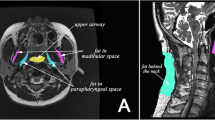Abstract
The aim of this study is to analyze the relationships between obesity, fat distribution and pharyngeal transversal area in women. Cross-sectional areas of the pharynx at the oro-pharyngeal junction and at the glottis and mean pharyngeal area were measured by acoustic pharyngometry in 145 women (age 42.9 ± 15.1 years; range 14–82 years). Body weight, waist, hip and neck circumferences, and sagittal abdominal diameter (SAD) were determined. Pharyngeal area at the oro-pharyngeal junction, measured both in orthostatic and in lying position, was negatively related to BMI, waist, hip and SAD. Mean pharyngeal area was negatively related to BMI and to SAD only in orthostatic position. No significant correlations were found between pharyngeal areas at the glottis and any anthropometric measurements. In multiple regression analysis, only SAD retained independent relationship with pharyngeal area at the level of the oro-pharyngeal junction in both the positions and with mean pharyngeal area in the orthostatic position. We demonstrated an inverse association between upper airways size and both adiposity and visceral fat distribution in women.

Similar content being viewed by others
References
Malhotra A, White DP (2002) Obstructive sleep apnoea. Lancet 360:237–245. doi:10.1016/S0140-6736(02)09464-3
Shelton KE, Woodson H, Gay S, Suratt PM (1993) Pharyngeal fat in obstructive sleep apnoea. Am Rev Respir Dis 148:462–466
Horner RL, Mohiaddin RH, Lowell DG, Shea SA, Burman ED, Longmore DB et al (1989) Sites and sizes of fat deposits around the pharynx in obese patients with obstructive sleep apnoea and weight matched controls. Eur Respir J 2:613–622
Mortimore IL, Marshall I, Wraith PK, Sellar RJ, Douglas NJ (1998) Neck and total body fat deposition in nonobese and obese patients with sleep apnea compared with that in control subjects. Am J Respir Crit Care Med 157:280–283
Shinohara E, Kihara S, Yamashita S, Yamane M, Nishida M, Arai T et al (1997) Visceral fat accumulation as an important risk factor for obstructive sleep apnoea syndrome in obese subjects. J Intern Med 241:11–18. doi:10.1046/j.1365-2796.1997.63889000.x
Vgontzas AN, Papanicolaou DA, Bixler EO, Hopper K, Lotsikas A, Lin HM et al (2000) Sleep apnea and daytime sleepiness and fatigue: relation to visceral obesity, insulin resistance, and hypercytokinemia. J Clin Endocrinol Metab 85:1151–1158. doi:10.1210/jc.85.3.1151
Lohman TG, Roche AF, Mortarell R (1988) Anthropometric standardisation reference manual. Human Kinetics Books, Chaimpaign, IL, USA
Armellini F, Zamboni M, Harris T, Micciolo R, Bosello O (1997) Sagittal diameter minus subcutaneous thickness An easy to obtain parameter that improves visceral fat prediction. Obes Res 5:315–320
Davies RJO, Stradling JR (1990) The relationship between neck circumference, radiographic pharingeal anatomy and the obstructive sleep apnea syndrome. Eur Respir J 3:509–514
Busetto L, Enzi G, Inelmen EM, Costa G, Negrin V, Sergi G et al (2005) Obstructive sleep apnea syndrome in morbid obesity: effects of intragastric balloon. Chest 128:618–623. doi:10.1378/chest.128.2.618
Kamal I (2001) Normal standard curve for acoustic pharyngometry. Otolaryngol Head Neck Surg 124:323–330. doi:10.1067/mhn.2001.113136
Martin SE, Mathur R, Marshall I, Douglas NJ (1997) The effect of age, sex, obesity and posture on upper airway size. Eur Respir J 10:2087–2090. doi:10.1183/09031936.97.10092087
Haponik EF, Smith PL, Bohlman ME, Allen RP, Goldman SM, Bleecker ER (1983) Computerized tomography in obstructive sleep apnea Correlation of airway size with physiology during sleep and wakefulness. Am Rev Respir Dis 127:221–226
Grunstein R, Wilcox I, Yang T-S, Gould Y, Hedner J (1993) Snoring and sleep apnoea in men: association with central obesity and hypertension. Int J Obes 17:533–540
D’Urzo AD, Rubinstein I, Lawson VG, Vassal KP, Rebuck AS, Slutsky AS et al (1988) Comparison of glottic areas measured by acoustic reflections vs computerized tomography. J Appl Physiol 64:367–370
Marshall I, Maran NJ, Martin S, Jan MA, Rimmington JE, Best JJ et al (1993) Acoustic reflectometry for airway measurements in man: implementation and validation. Physiol Meas 14:157–169. doi:10.1088/0967-3334/14/2/007
Author information
Authors and Affiliations
Corresponding author
Rights and permissions
About this article
Cite this article
Busetto, L., Calo’, E., Mazza, M. et al. Upper airway size is related to obesity and body fat distribution in women. Eur Arch Otorhinolaryngol 266, 559–563 (2009). https://doi.org/10.1007/s00405-008-0773-y
Received:
Accepted:
Published:
Issue Date:
DOI: https://doi.org/10.1007/s00405-008-0773-y




